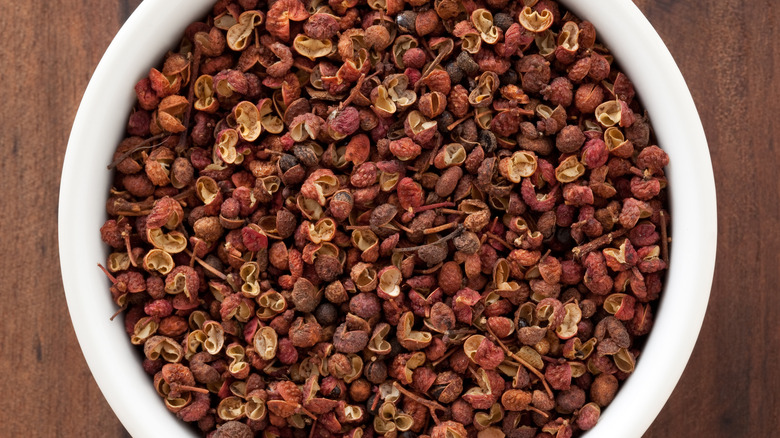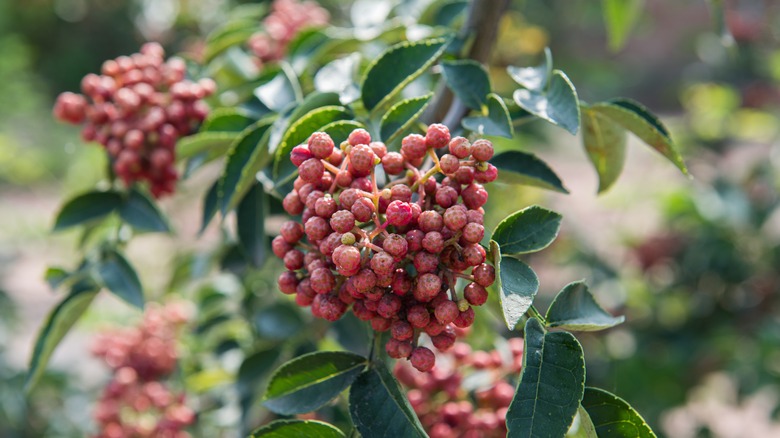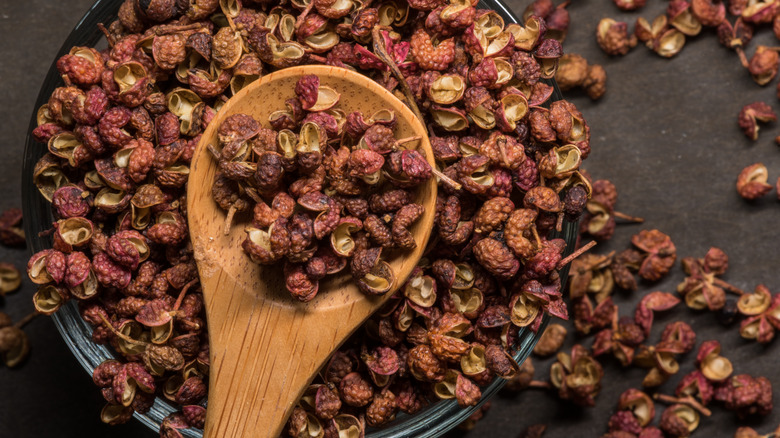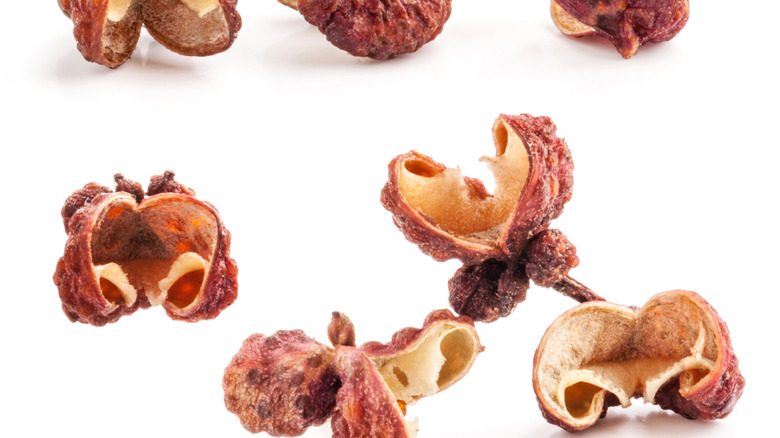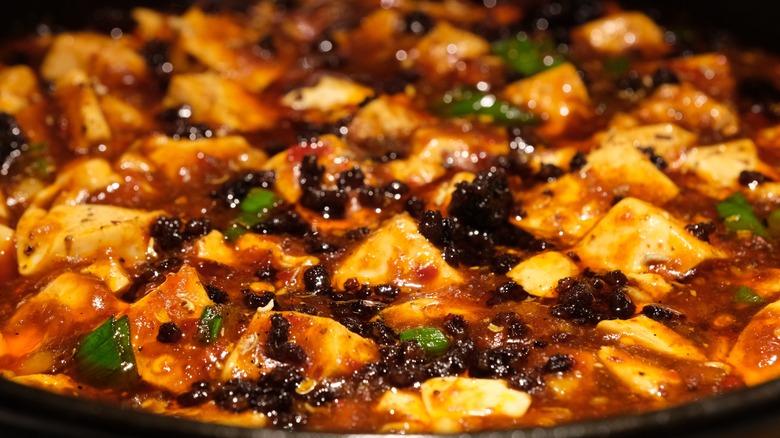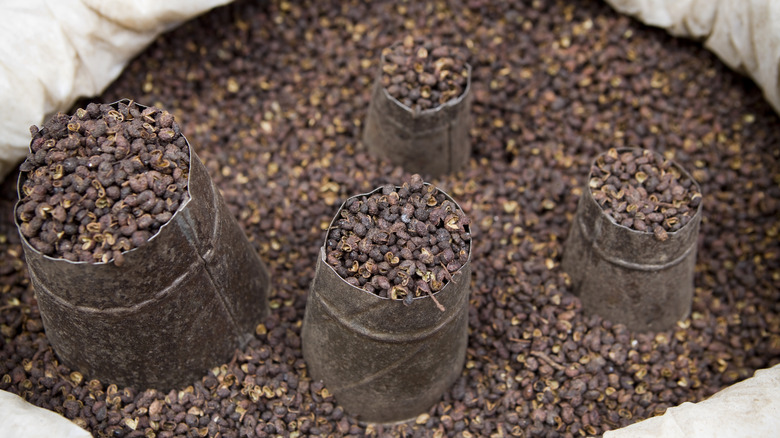Sichuan Peppers Are The Palate-Vibrating Ingredient Your Dish Needs
Sichuan cuisine is, like all other regional Chinese cooking styles, complex. Flavors are brought together with mastery as ingredients that are sour, bitter, spicy, tangy, sweet, umami, smoky, and more are layered into a dish. No one ingredient merits more importance than the others in service of the final product. That said, Sichuan — sometimes rendered Szechuan — cuisine boasts a most-singular ingredient, a ruddy, piquant pearl that's responsible for one of its most identifiable flavor notes: Sichuan pepper.
If you've ever experienced the famed málà — a combination of two words meaning "numbing" and "spicy" — considered a hallmark of Sichuan cuisine, then you've encountered Sichuan pepper. It claims responsibility for the "numbing" part of the equation, though numb doesn't quite fully describe the sensation of eating one of these small pods. It can be numbing, but also fruity and tingly, almost electric in a strictly non-painful sense. Sichuan pepper doesn't elicit a burn the way other peppers or peppercorns do. You're eyes likely won't water and you probably won't burst into a sneezing fit.
All the same, Sichuan pepper is typically grouped with spicy ingredients because they play well together. As we sit here in summer, a season of spicy fare, let's explore this fascinating pepper with a utility that extends beyond its native cuisine.
Where does Sichuan pepper come from?
Sichuan pepper, scientifically known as Zanthoxylum simulans, originates from the Sichuan region of China, which sits within the upper Yangtze River Valley. Despite its name, Sichuan pepper is not a true peppercorn, but rather the dried outer husk of the fruit produced by the prickly ash tree. This spice has been a cornerstone of Sichuan cuisine for centuries, renowned for its distinct flavor and unique tingling sensation.
The cultivation of Sichuan pepper primarily takes place in the provinces of Sichuan, Yunnan, particularly for green Sichuan pepper, and Guizhou in southwestern China. These regions offer the ideal conditions for the growth and development of the prickly ash tree. The warm and humid climate, coupled with fertile soils, contributes to the production of high-quality Sichuan pepper.
The process of harvesting Sichuan pepper begins with the collection of the fruit from the trees. The fruit is then dried, allowing the outer husk to shrink and separate from the seed. The resulting dried husks, known as "husk-pepper," are what we commonly recognize as Sichuan pepper.
What does Sichuan pepper taste like?
So, if Sichuan pepper isn't spicy, per se, then what is going on with that remarkable tingling sensation that dances across your palate? The secret lies in the hydroxy-alpha-sanshool compound present in Sichuan pepper. It is believed that hydroxy-alpha sanshool elicits a response known as paresthesia, similar to the "pins and needles" sensation that people sometimes feel in their legs. It does this by acting on the trigeminal nerve, a part of the nervous system that responds to stimuli in the face and mouth other than taste. That's why people often reach for tactile descriptors for Sichuan pepper rather than those more closely associated with flavor.
The tingling sensation produced by Sichuan pepper differs significantly from the heat of chili peppers. This fiery sensation is the result of a compound called capsaicin, found in chili peppers, which triggers the body's pain receptors. Known as VR1 receptors, these send signals to the brain, triggering the release of endorphins. These natural opioids act as painkillers and mood boosters, creating a pleasurable sensation amidst the initial heat.
Málà seamlessly combines the fiery heat of chili peppers with the distinctive numbing sensation of Sichuan pepper. The chili peppers provide a robust spiciness that ignites the palate, while the Sichuan pepper adds an electrifying tingle that simultaneously numbs and heightens the senses. It testifies to the artistry of Sichuan cuisine, capturing the essence of boldness and complexity in every bite.
Sichuan pepper vs. black pepper
Clearly, Sichuan pepper and chilies are a world apart in terms of their individual methods of action. But what about Sichuan pepper and that other pepper, the one it kind of looks like — at least in their whole forms: black pepper? While both Sichuan pepper and black pepper — scientifically known as Piper nigrum — belong to the culinary pepper family, they each bring their own distinct personalities to the culinary world. Sichuan pepper and black pepper differ in their origins, flavor profiles, and usage.
Various regions across the globe, including India, Vietnam, Indonesia, and Brazil, cultivate Black pepper. Each region imparts its unique characteristics to the spice, resulting in subtle differences in taste and aroma. Indian black pepper, for example, is known for its bold and robust flavor, while Vietnamese black pepper has a milder and more floral quality. When it comes to taste, black pepper offers a pungent and sharp heat that lingers on the palate. Its flavor profile is characterized by its slightly earthy notes, adding depth and complexity to dishes.
Black pepper differs from Sichuan pepper in several ways. Firstly, black pepper belongs to the Piperaceae family, while Sichuan pepper belongs to the Rutaceae family. Second, black pepper provides a fiery heat without the tingling sensation found in Sichuan pepper. Lastly, black pepper is used in a wide range of cuisines globally, whereas Sichuan pepper is primarily associated with Sichuan cuisine, famed for its numbing and spicy flavor.
How to cook with Sichuan pepper
When using Sichuan pepper, it's best to start with whole peppercorns and toast them lightly in a dry pan over low heat until fragrant. They can be used whole in dishes that call for a bit more texture. If you need a finer consistency, grind them using a mortar and pestle or a spice grinder. This process releases the full complexity of the spice, ensuring its flavors infuse your dishes.
One iconic Sichuan dish that showcases the power of Sichuan pepper is mapo tofu. In this fiery and numbing delicacy, ground pork, fermented black beans, garlic, and chili oil combine with the unmistakable tingle of Sichuan pepper. The result is a symphony of flavors that dance on your taste buds, creating a harmonious balance of heat and numbing sensation.
Another popular dish, Kung Pao Chicken, features tender chicken, crunchy peanuts, and a medley of vegetables stir-fried in a spicy Sichuan pepper sauce. The numbing effect of the pepper complements the heat of the dish, creating a delightful contrast that keeps your palate engaged.
Dan dan noodles, a classic street food favorite, are another example of Sichuan pepper's prowess. The combination of chewy noodles, savory minced pork, and a fiery Sichuan pepper sauce creates a mouthwatering, impossible-to-resist dish.
Where to buy Sichuan pepper?
Fortunately, you don't need to travel to the mountains of Sichuan to embark on a culinary adventure with Sichuan pepper. In the United States, this delightful spice can be found in specialty spice stores and Asian food markets, and via online retailers.
Specialty spice stores often stock a wide variety of spices from around the world, including Sichuan pepper. These establishments are havens for culinary enthusiasts and provide an opportunity to explore the vast world of flavors.
Asian food markets are another excellent source of Sichuan pepper, as they offer an array of authentic ingredients used in Asian cuisine. Whether you're seeking whole peppercorns or ground Sichuan pepper, these markets are treasure troves waiting to be explored.
Lastly, online retailers provide convenience and accessibility, allowing you to order Sichuan pepper from the comfort of your own home. A quick search will unveil a multitude of options, ensuring you can embark on your Sichuan pepper culinary journey with ease.
